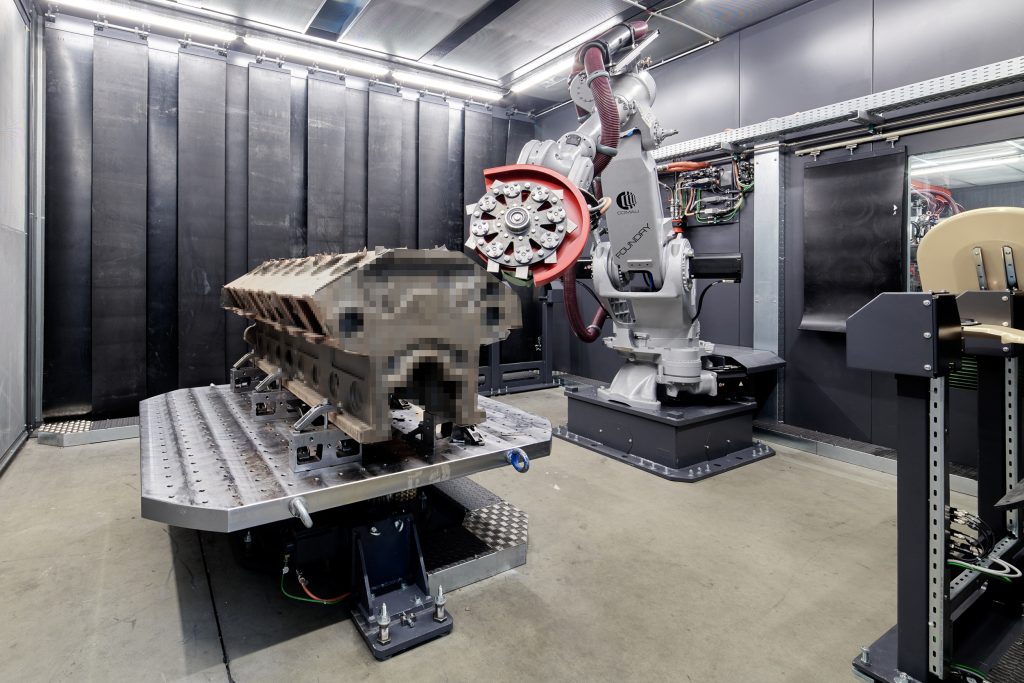Development of the GRIND PERFORMER F heralds a new era in iron casting. The high-tech fettling and grinding cell is operated by an industrial robot. Thanks to an automated tool replacement system, it can carry out the various operations fully automatically, whether deburring small iron castings or massive ones. In addition to tremendous time savings in machining, the GRIND PERFORMER F ensures flexibility, high quality, and reproducibility of the machining operations. Another major benefit of the system is a substantial improvement in working conditions in the area of iron casting.
Gurten, November 8, 2021 – “With development of the GRIND PERFORMER F, we have brought the world of iron casting into the modern age. Machining iron castings of any size was previously back-breaking manual work in the most difficult working conditions. Thanks to state-of-the-art technology it has been elevated to a new, contemporary level. Day-to-day work in machining iron casting is now effectively much easier,” explains Thomas Rathner, Head of the Casting Technology Competence Center at Fill.
Development fueled by years of expertise
The machine engineering experts at Fill have been developing and supplying casting systems and machines for over 25 years. With the GRIND PERFORMER F, an important new milestone has been reached in the machining of iron castings. Components are fed into the robot grinding and deburring machine either manually or automatically. A robot-guided quick-change system automatically accesses various machining tools to fettle the component. To improve the reach and access of the robot, the individual component can be turned on the rotary clamping table. Depending on requirements, the GRIND PERFORMER F can be operated either as a standalone machine or in combination with several other machines.
Easily operated interface
The GRIND PERFORMER F is operated using FILL STUDIO. This software package was developed by Fill itself and enables easy programming. The employee on the system needs no specific prior knowledge to be able to operate it within a very short time. The tool is selected on the user interface, then the operations are determined on the 3D model using visual settings. “When developing FILL STUDIO, we paid particular attention to making the software easy to use, which is why the entire trajectory generation is programmed visually. The operator does not need to be an expert in robots or simulation, just a technician in the field of machining iron castings,” explains Tobias Wageneder, who is responsible for software engineering, simulation and virtual commissioning at Fill.
Corporate data
Fill is a leading international machine engineering company based in Gurten, Upper Austria. With sophisticated high-tech systems and custom manufacturing solutions for metal, plastics and wood, Fill makes its customers the best in their fields. The automotive, aviation, sports and building industries all benefit from Fill’s expertise. Since it was founded in 1966, the company has distinguished itself through enormous innovative strength, strong values and the best jobs. “If you are seeking the best solution, shape your future with Fill” is the guiding principle of the company’s more than 950 employees. “Wir sind 1! We are one!” is their vision and stands for togetherness not only with the team, but also with customers, suppliers and partners. The company is 100 percent family-owned and is managed by Andreas Fill (CEO), Martin Reiter (CSO), Alois Wiesinger (CTO) and Günter Redhammer (COO). In 2020, Fill recorded sales of around 144 million euros.
Further information can be found at: www.fill.co.at


